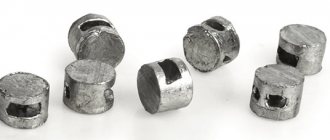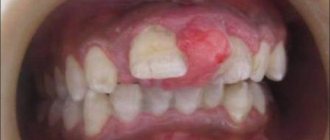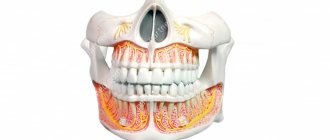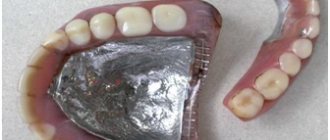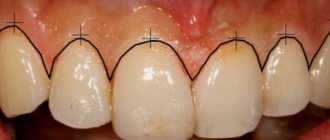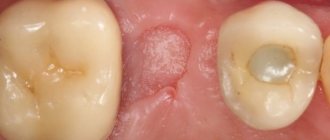Indications and contraindications
Most often, implants are placed for problems with the front teeth, since removable dentures look unnatural and have certain disadvantages.
Indications for implantation:
- Congenital defects or destruction of individual teeth;
- Inadequate chewing process due to dentition;
- The patient’s reluctance to wear removable dentures in the absence of several teeth;
- Allergy to materials used in classical prosthetics;
- Increased gag reflex, preventing the wearing of removable structures;
- Hypersensitivity of tooth enamel;
- Malocclusion;
- Tooth injury.
Sometimes a specialist advises postponing implantation or replacing it with another type of prosthetics. Installation of implants may not be recommended for a patient in the following cases:
- impaired blood clotting;
- oncological diseases;
- inflammation in the oral cavity;
- weakened immune defense;
- metabolic disorders in the body;
- diabetes;
- destruction of connective tissue in the jaw area;
- venereal diseases;
- mental illness;
- heart pathologies.
The procedure will have to be postponed in case of pregnancy, vitamin deficiency, the presence of extensive carious lesions or pulpitis, abnormalities of the jaw joint, or exacerbation of periodontal disease.
Advantages and disadvantages
Dental implantology is a field that has many advantages. After the operation, the aesthetic appeal of the smile is completely restored. This procedure is low-traumatic and reliable. After installation of the implant, the patient can speak and eat normally.
Despite the huge number of advantages, implantation of implant structures has the following disadvantages:
- There is a risk of implant rejection (less than 5%);
- A large number of contraindications;
- Duration of the procedure;
- High price.
The implant may not take root due to the individual characteristics of the patient, due to proper oral care, due to the use of low-quality material, or due to improper installation. In particularly advanced cases, the duration of the procedure can reach six months. The cost of installing an implant is much higher than performing simple prosthetics.
Implantation stages
At the preparatory stage, the doctor conducts an examination and prescribes the necessary tests. If the patient has no contraindications to implantation, he is given anesthesia and proceeds directly to the operation. A titanium rod is inserted into the bone tissue, on which the crown will subsequently be fixed.
During express implantation, which is carried out in one day, the outer part of the tooth is installed immediately after fixing the pin. In the classic procedure, a metal rod is first implanted into the patient, and the crown itself is placed a few months later.
During the initial examination, the doctor pays attention to the following points:
- patient's age;
- his general health;
- the presence or absence of pathology of teeth and gums;
- the amount of bone tissue at the site of prosthetics;
- degree of blood supply to the gums;
- hygienic condition of the oral cavity.
There are no restrictions up to what age dental implants can be placed. The only question is the general health of the patient - under favorable circumstances, they can be diagnosed at 70 years of age.
After examining the oral cavity, the dentist sanitizes it, healing carious teeth in order to maximally protect the wound from bacteria at the time of surgery. Along the way, the doctor must find out whether there is an allergic reaction to the anesthesia used, and in difficult cases, do an MRI of the jaw.
Pin insertion
Answering the question whether it is painful to install a dental implant, we can confidently say that at this moment the patient does not feel pain. The injection through which anesthesia is administered causes a slightly painful sensation, after which sensitivity is lost for the entire period of the operation. The intervention does not last long.
It takes only 10 minutes to place one prosthesis. Installing multiple implants takes less than an hour. In the case when the patient does not have additional time, he can have a crown installed immediately, but it is advisable to do this after 2-3 days, when the inflammation caused by the incision of the soft tissues decreases.
If there is not enough bone tissue for implantation, the doctor has to increase it. This process is carried out using bone grafting and sinus lifting, which also take place under local anesthesia. The dose of the painkiller is calculated by the doctor so that the effect lasts until the end of the procedure.
During the classic procedure, the implantologist makes an incision in the gum to reach the bone tissue, where the implant is implanted. If necessary, bone tissue is increased before installing the pin. The titanium rod is then screwed into the bone and the incision is sutured.
Fixation of abutment and crown
After the rod is mounted, an abutment is fixed on it - a titanium head that connects the pin and the crown. This part protrudes above the gum by 2.5 mm. This technology allows you to correct the angle of the tooth, if necessary. The abutment can also be used to attach a removable denture.
The crown is made of metal and covered with a ceramic layer if the fitting was successful. If errors are found, the craftsman sharpens the product. The crown is fixed to the abutment using dental cement.
First, the structure is fixed temporarily. If the patient does not experience discomfort or complain, the crown is secured with especially strong cement. It can only be removed by sawing.
Express prosthetics method
Some patients resort to basal implantation. This is the name of the procedure during which the doctor places implants in one visit. This implantation is carried out using a gentle method. Instead of an incision, a puncture is made in the gum, which reduces blood loss, swelling and inflammation.
After basal implantation, chewing function is completely restored within a few days. In this procedure, smaller diameter titanium rods are screwed deep into the bone and a crown is placed on the same day. This method is especially popular for loss of front teeth.
If it is necessary to insert the entire jaw, use the “all-on-4” or “all-on-6” techniques. Their essence is to attach the prosthesis to 4 or 6 implants, two of which are located in the frontal region, and the rest in the area of the chewing teeth. Indications and contraindications for this type of prosthetics are determined by the doctor.
Types of implants
There are different models of implant structures. Each of them is intended for a specific clinical case. The following varieties are distinguished:
- Classic;
- Short;
- Mini implants;
- Intramucosal;
- Basal;
- Zygomatic.
The classic type of root implants is presented in the form of an elongated cylinder or tooth root. Their length is 6−7 mm. Such products can be used in almost all clinical cases. In areas with minimal bone tissue, short implants of 3–6 mm are installed. Their stability and reliability is ensured by their large width.
Classic and basal
Extended basal products are installed directly into the basal bone. They take root best in patients with diabetes and smokers. Zygomatic varieties are placed in the cheek bone. Used when the amount of bone tissue is minimal. They serve as an excellent fixation for a bridge or fixed prosthesis.
Mini-implants are used to create temporary support for prosthetics or as additional reinforcement for installing braces.
Mini implants
Intramucosal models are fixed not in the bone tissue, but in the mucous membrane. Most often they are used to fix removable dentures in elderly people.
Postoperative period
After the anesthesia wears off, the patient will experience discomfort. The duration and intensity of pain is an individual indicator. In general, the nature of the pain can be compared to the condition that a person experiences after tooth extraction. If a laser was used to insert the pin during implantation, the pain will be less pronounced.
Patients characterize pain after prosthetics as:
- bursting;
- pressing;
- cutting;
- burning;
- pulsating;
- spicy;
- paroxysmal.
The pain syndrome can be localized or cover the entire oral cavity. For some people, the pain radiates to areas distant from where the surgery was performed. The patient may experience itching near the wound. All these unpleasant sensations are considered normal if they last no more than 4-5 days.
After the operation, the doctor prescribes painkillers that eliminate pain. If the symptoms last longer and increase, it is necessary to visit the dentist, since such a clinical picture may indicate the formation of an inflammatory process.
Complications in the postoperative period may be associated with doctor errors, incorrect actions of the patient and the characteristics of his body. The most severe consequences include implant rejection and reimplantitis.
Operation stages
Replantation is performed under local anesthesia. The first stage involves carefully removing the tooth. First, the ligament peels off from the neck, and then the entire tooth. Movements must be as precise as possible to prevent major damage.
The step-by-step procedure in the photo looks like this:
After removal, the periodontal pocket is thoroughly cleaned. This is necessary in order to remove granuloma or granulations. The replantant is placed in a warm sodium chloride solution. To avoid infection, antibacterial agents are added to the solution. The hole is closed with a sterile gauze swab.
The second stage of the operation consists of processing the replantant itself. The doctor must fill all carious lesions, perform resection of the root tips and widen the canals. All deposits and parts of the mucous membrane are removed from the dental neck. The replantant should remain in sodium chloride solution immediately until transplantation.
The third stage is the implantation of a replantant. To do this, the upper part of the root system is cut down. Before placing the tooth in the socket, the doctor must completely remove any blood clots that may be present in it. The tooth is placed directly into the alveolus. No additional fixation is required. Engraftment with proper restoration takes about 20 days.
Implant rejection
If the titanium pin is not accepted by the bone tissue, the patient will experience bleeding, severe swelling, sharp persistent pain, mobility of the structure, and accumulation of pus in the operated gum. Your overall body temperature may increase.
Rejection of the implant can be caused by the fact that the doctor did not maintain the necessary sterility, the preparation for the operation was carried out with violations, the pin was incorrectly selected, the bone had insufficient volume or was injured. If the above errors are made, the pin will be rejected within the first month after implantation.
A similar nuisance can also happen due to the patient’s fault if he does not take the prescribed antibacterial agents, carry out proper hygienic care, and starts consuming solid foods in the first days after surgery.
Visiting the sauna in the first month after prosthetics, smoking and alcohol abuse can lead to implant rejection. Sometimes such consequences can be caused by the anatomical features of the jaw or the individual reaction of the body to a foreign body.
Since the procedure is considered a type of surgery, many people are afraid of the pain associated with dental implants. They want to know in advance how long and intense it will be. Answer below:
Period of osseointegration (engraftment of the pin)
One of the main conditions for implantation using the classical method is that the patient has the required amount of bone tissue. If it is not enough, the doctor performs a procedure called augmentation. Thus, surgery to increase bone tissue in the upper jaw is called a sinus lift. It consists of lifting the sagging bottom of the maxillary sinuses, and then filling the cavity with artificial or donor bone material. Implants can be placed after surgery or during surgery. The lower jaw is subject to guided bone regeneration or GBR.
After the metal root is implanted into the gum, the healing process occurs, which takes on average from two months to six months. After the gum has successfully healed, the doctor shapes it in order to create a natural contour of the tissue around the artificial tooth. This is done using a titanium cylinder, which is screwed into the previously installed implant. After a couple of weeks, a cushion of gum tissue appears around this element.
After these steps, an abutment is placed, which is the connecting link between the root and the crown. Installation takes no more than fifteen minutes. Abutments come in different sizes and shapes. A couple of days after the abutment is inserted, prosthetics are made. This action is considered the final stage of long-term dental implantation.
If there is a long gap between the moment of tooth extraction and implantation, the bone tissue atrophies, its volume decreases, which makes the implantation of a titanium pin impossible. In such cases, surgery is performed to increase bone tissue using one of the following methods:
- Guided regeneration involves the implantation of natural or synthetic material; the process of replenishing the missing bone volume takes approximately 4 months.
- Sinus lift.
- Replanting a bone block from the patient's tissues.
DETAILS: All about dental implantation in Dnipropetrovsk
This increases the preparation period by several months, otherwise implantation will be impossible.
After the operation, there is a period of implant engraftment in the bone tissue, which takes from 4 to 6 months. The duration of engraftment depends on the individual characteristics of the patient’s body. On the upper jaw, the pins take root faster than on the lower jaw.
Implantation is a complex operation accompanied by trauma to several layers of tissue in the oral cavity. This is stress for the body, which responds to injury with some unpleasant symptoms:
- pain in the operated area,
- swelling of the tissues, cheeks from the side of the operation,
- slight redness of the gums.
The above symptoms disappear gradually after 5-7 days. During this period, you can take painkillers prescribed by your doctor. Pain and swelling must subside, otherwise we are talking about the development of complications and you should not hesitate to seek medical help.
The period after installation of the prosthesis is called rehabilitation. Its duration is approximately 5-8 months. (depending on the number of artificial units and the condition of the oral cavity). Throughout this period, the patient must follow certain rules:
- Visit your dentist regularly to examine your dentures (the number and frequency of visits is determined by your doctor).
- Carry out professional hygienic cleaning at least once every 6 months.
- You should brush artificial teeth carefully (without pressure), using a brush with medium-hard bristles and a toothpaste without abrasive components.
- Use waxed floss and antiseptic rinses as additional hygiene products.
- Hard and solid foods should be excluded from the diet.
If the work of specialists is carried out correctly and in the future, if all recommendations and instructions for hygiene and care of artificial teeth are followed, the products will last quite a long time. The average duration of their operation is 10-12 years.
When performing turnkey dental implantation, restoration (building) of bone tissue is often required. This operation is called bone grafting. Already after 3 months after tooth extraction, bone tissue atrophy occurs as the load stops. After a year, this process reaches its peak.
To build teeth, it is better to contact an implantologist immediately after removal. Otherwise, you will have to resort to bone grafting. But this is not always required; in any case, the decision to perform it is made by the dentist. Since there are cases where, after a long absence of a tooth, bone tissue remains unchanged. Most often there are problems of bone atrophy or displacement of adjacent teeth.
The frontal part of the lower and upper jaws requires bone grafting more often, since a sharp and thin alveolar ridge quickly forms here. The plastic surgery of this part is quite complex, since it is necessary to achieve a good cosmetic result.
It is difficult to work with the lateral sections of the upper jaw because the maxillary sinuses are located here. Bone grafting of this section is called sinus lifting; there are open and closed versions of this operation.
Before you decide to have surgery, it is worth understanding that dental implantation has contraindications and possible complications.
The following reasons are considered complete contraindications to implantation:
- Oncological diseases, including during the treatment stage and after a course of therapy;
- Diabetes mellitus that cannot be corrected with drugs;
- Diseases of the central nervous system, including epilepsy;
- Grinding of teeth during sleep (bruxism);
- Problems with hematopoiesis, bleeding disorders;
- Immunity disorders of various etiologies;
- Lupus erythematosus;
- Bone tuberculosis;
- Arthritis.
As for relative contraindications, many implantologists believe that they do not exist. If there are no insurmountable reasons why implantation is contraindicated, other reasons can be eliminated through the efforts of the patient and the doctor.
The dentist prepares the oral cavity for surgery so that it is in a condition that guarantees a successful result in the installation of implants and gives a good prognosis for their future use.
During the postoperative period, some complications may arise that must be eliminated. The survival rate of the implant depends on the patient’s physical condition and physiological characteristics. Since a foreign body is implanted and surgically placed into the gum, it is quite difficult to predict in advance how the procedure will go.
The most common types of complications after dental implantation are:
- Pain and bleeding;
- Inflammation of soft tissues around adjacent teeth%
- Hematomas near the intervention site;
- The seams are coming apart.
The most significant complication is implant failure.
To avoid negative consequences, you must strictly follow all the recommendations of your doctor and monitor your oral hygiene. According to reviews, most implantation operations are successful, and if all conditions are met, serious complications can be avoided. Allergy to dentures is very rare.
After all stages of the operation have been completed and dentures have been inserted, there is no longer a need to visit the dentist. For preventive purposes, it is worth visiting the clinic to identify possible deviations and other problems with dental health.
DETAILS: Price list of dentistry Stomus on Julius Fucik Street - Medical centers
Implants are made of titanium, which is considered an absolutely safe material for human health. At the same time, there is a small risk of its rejection and problems with implantation. This depends on several factors, the most important of which are:
- Type of implants;
- Professionalism of the implantologist;
- Individual characteristics of the body, in particular, the state of the person’s immune system, or the presence of health problems.
Practice shows that dental implants take root in 98 percent of cases, which is ensured by the use of advanced technologies for medical intervention, high-quality materials, and ultra-modern equipment.
Before their installation, the patient undergoes a full examination, which ensures a positive result and negates the risks of implant rejection. For each artificial tooth installed by the clinic, a certain guarantee is given.
Inflammatory process or reimplantitis
Reimplantitis is characterized by thinning and destruction of bone tissue in the period after dental implantation. In place of the decayed bone tissue, granulate is formed. The inflammatory process is accompanied by the formation of connective fibers, which over time turn into scars.
If you do not pay due attention to this process, the implant will be rejected. Inflammation is accompanied by severe pain and tissue bleeding at the site where the titanium rod is inserted. The gums turn red, become loose and begin to flake off. Possible suppuration and fistula formation. The product becomes movable.
Reimplantitis is one of the popular complications
Factors that provoke reimplantitis: diabetes mellitus, impaired immune function, gum injury during surgery, the formation of an internal hematoma, incorrectly chosen implantation tactics by the doctor, violation of dental hygiene standards, abuse of cigarettes and alcohol.
Preparatory
Implantation is a kind of surgical intervention that requires careful preparation. Sometimes, the duration of this stage can vary from one week to a month.
Experts carefully evaluate the possibility of the body accepting a foreign body.
Initial visit
Initially, a patient who wants to restore a completely lost tooth visits a dentist for a consultative purpose. The specialist visually examines the oral cavity, assesses the condition of the jaws, and finds out information about concomitant diseases.
Planning
After the examination, the dentist draws up a detailed plan for preparing for implantation. It includes diagnostics of the oral cavity and general condition of the body, as well as the necessary stages of treatment for problem teeth and periodontal diseases.
The duration of the preparatory period depends entirely on the individual characteristics of the patient and his medical history.
Diagnostics
In order to get an idea of the anatomical structure of the jaw bones, dentists prescribe the following examination methods:
- X-ray diagnostics – allows you to obtain an image detailing the condition of the area for implantation and the health of the root system of adjacent teeth;
- orthopantomogram - obtaining a panoramic image of the structure and volume of bone tissue as a whole;
- computed tomography is an examination technique that allows you to obtain a three-dimensional image of bone tissue. With its help, you can evaluate not only the structure, but also the density of the bone.
Positive and negative aspects of the method of silvering baby teeth, as well as alternative ways to prevent caries. Come here to find out what to do if your wisdom tooth is loose.
At this address https://dr-zubov.ru/krasota-i-uxod/otbelivanie/ofisnoe/lak-momentalnoe-sredstvo.html we offer you a closer look at dental varnish.
Taking tests
The necessary tests before implantation are usually scheduled no later than 2 weeks before the procedure.
In order to avoid a number of complications of surgical intervention, the patient is required to provide the results:
- general blood and urine analysis;
- tests for fibrinogen and prothrombin;
- analysis of blood clotting and platelet formation;
- the presence of antibodies in the body to HIV, syphilis and various hepatitis;
- biochemical blood tests, including blood glucose levels.
Depending on the individual characteristics of the body, the patient may also be assigned a consultation with other highly specialized specialists who may recommend a number of additional examinations.
Sanitation of the oral cavity
After the diagnostic results have excluded all possible contraindications to implantation, the specialist begins treatment of all problems of the oral cavity.
At this stage, professional cleaning is carried out, teeth that have undergone a carious process are filled, and all sources of inflammation and infection are eliminated. Bone tissue restoration
Sanitation of the oral cavity alone is not enough to begin implantation of a titanium root.
The condition of the jaw bone plays an important role in carrying out prosthetics using the universal method. The base for the implant must have a standard density and height.
Especially, areas that have been empty without a tooth for quite a long time need restoration of bone tissue.
Its compaction is ensured by using one of the following methods:
- Guided regeneration is a technique of implanting artificial material or natural tissue in order to restore the bone parameters necessary for implantation. Prosthetics are allowed 4 months after the procedure.
- Replanting a bone block taken from another area of the body . The technique is relevant for the development of the resorption process of bone tissue. This method allows implantation to be carried out after 5 months.
- Sinus lifting is a technique whose purpose is to raise the height of the mucous membrane of the bottom of the maxillary sinus to increase the volume of bone tissue of the upper jaw. The average waiting time between this procedure and the installation of the implant is 5 months.
What is a sinus lift - Dr. Levin D.V. will tell you in detail. in the following video:
Reducing pain during rehabilitation
To reduce pain after implantation, you must strictly follow all doctor’s instructions. In addition to taking painkillers, the following rules will help relieve pain and speed up healing:
- In the first days after the procedure, avoid eating hot and spicy foods.
- Products must be crushed and have a soft consistency.
- It is necessary to exclude travel by plane and refuse to visit baths, saunas, and swimming pools.
- You need to rinse your mouth with an antiseptic solution several times a day.
- For the first week, it is better to sleep on a high pillow to reduce blood flow to the head.
- It is advisable to avoid physical activity and stress.
- During the healing period, you need to brush your teeth with a brush with soft bristles, acting as carefully as possible, without affecting the implant area.
- It is recommended to treat the pin itself with a cotton swab soaked in saline solution.
- Oral baths with an antiseptic are also shown.
Careful hygiene will prevent the proliferation of pathogenic microflora and the development of complications. The service life of the implant in the future depends on its observance in the first days.
Prices for turnkey dental implantation in Moscow
The cost of the procedure depends on the materials, the company manufacturing the structures, the volume and complexity of the work, and aesthetic requirements. Our services are affordable and provided by professionals.
Initial consultation
- Oral examination
- Making a treatment plan
- Drawing up a treatment estimate
For free
Reliable implantation is facilitated not only by the latter’s experience and adherence to technology, but also by:
- metal bioinertness;
- porous-rough surface of the structure;
- special coating of parts that stimulates bone growth and the implantation process;
- The shape of the structure follows the shape of a natural tooth.
Patient reviews
For those who are concerned about whether it hurts to get dental implants, reviews from people who have undergone the procedure will allow them to set themselves in the right mood.
I was careful when choosing a clinic. I settled on a more expensive establishment and did not regret it. I got an implant a few days ago. During the procedure I felt only vibration. After this, the swelling subsided by evening, there is no pain, I eat almost everything. I advise you to choose a doctor based on recommendations.
Anna, Moscow
I recently had an implant with bone augmentation placed. The pain lasted for about a week. I recommend taking a vacation during implantation. The condition is still not pleasant. Although everything is individual, I guess.
Marina, Moscow
I had two implants installed at once, the operation took about 40 minutes.
I was a little afraid because I didn’t know if it would hurt to get dental implants. I can say that during the operation itself I did not feel anything at all, and after that there was only minor swelling. To prevent pain, for the first two days I took painkillers prescribed by the doctor. Everything healed pretty quickly. The main thing is to rinse your mouth often and not eat solid foods. Nastya, Pskov
Types of implantation
The following types of implantation are distinguished:
One-stage dental implantation
The surgical intervention involves the implantation of an artificial root, which is installed with a crown within three days. It secures the position of the roots, and chewing pressure stimulates blood flow and regeneration of the solid organ.
An impression should be made in advance to be recreated in a dental laboratory. With express implantation, the rod is fixed into the deep parts of the jaw, which eliminates augmentation.
It is carried out in one stage after careful preparation of the oral cavity. The pin is screwed in under local anesthesia. An incision is made in the gum and no stitches are required. The minimally invasive nature of the intervention shortens the rehabilitation period.
Advantages of one-step implant installation:
- finished result in three days;
- non-invasive;
- no need for sinus lift;
- aesthetics;
- durability;
- saving time and money.
One-stage dental implantation
It involves installing an implant immediately after tooth extraction in one visit. After which the doctor places a temporary crown, and after 40-60 days a permanent crown is placed on the implant.
In practice, it is used quite often, but this type of implantation requires a sufficient amount of bone tissue. It is expensive. The risk of rejection of the installed implant is negligible. Preserves the gum contour and eliminates the need for augmentation. Allows you to achieve maximum attractiveness.
Disadvantage: requirements for the health of the oral cavity at the time of dental implantation; the absence of catarrhal phenomena and general problems at the time of surgical procedures is necessary.
Two-stage dental implantation
Classic two-stage implantation provides for late orthopedics - crowns are placed 3-6 months after installation of the implants. Provided in 2 stages.
At the first stage, the doctor makes an incision in the gum, exposing the bone, in which he makes a hole with a pinhole punch. The implant is placed in the finished hole. The gums are sutured. The period of fusion of the implant with soft tissues takes from 3 to 6 months. During this time, temporary plastic crowns are installed. They perform aesthetic activities in full, and chewing partially - you can only eat soft, crushed food.
At the second stage, the specialist removes the plug from the implanted implant, installs the former, thereby preparing the gums for orthopedic work.
The overlay improves the fixation of the permanent structure, giving maximum authenticity. After successful formation of the notch, the contour is removed. An abutment is attached to the implant and a permanent crown is placed.
Specifics of two-stage implant installation:
- the need for preliminary diagnosis;
- preparation of the oral cavity, relief of local diseases;
- the need for bone grafting;
- caution in eating until the end of osteoregeneration.
Mini implantation
In our dentistry you can use the mini-implantation service. It involves the use of implants reduced in size to 1.8 mm.
The installation of a mini-implant is used when there is insufficient bone tissue, to avoid tissue injury. It differs in that the patient will not spend a lot of money on this procedure. Involves immediate loading of the crown. The duration of the procedure varies from 30 to 90 minutes.
Disadvantage - insignificant durability - excessive chewing pressure is dangerous for destruction, so insert dentures are mounted on mini-pins.
Combined installation of implants
Combined transplantation combines several techniques to achieve optimal results. The main indication is the restoration of units in different rows and sections of the same row, edentia. An individual method, selected based on the client’s health status, limitations, financial condition and wishes.
Combination variations:
- Restoration of the smile area using express techniques. Molars are restored using a classic or basal technique, since they bear the greatest chewing load;
- A combination of different dimensions, based on the volume of the bone;
- A combination of removable and non-removable structures fixed to various implants.
The positive nature of the combination:
- maximum aesthetics and functionality;
- combining the capabilities of each method;
- avoids augmentation;
- reduces the cost of work.
Reviews
Today, the optimal and popular option to restore lost teeth is classical implantation. This is a reliable and durable method that allows you to fully replace lost units.
The time and money spent on this procedure are compensated by a beautiful smile and restoration of chewing function.
- Cost and prices of dental implantation
- Dental implantation procedure and time
- What tests are taken before dental implantation? Features of preparation
- Modern dental implant procedure
Abutment installation
It is performed after the implant has completely healed.
It is an operation at the site of the installed implant.
The morbidity of this stage is limited to a small area of the mucous membrane.
- An incision is made in the gum, the implant is opened and a gum former protruding into the oral cavity is screwed to it.
- After a few days, the gum former is removed, after which an abutment is placed.
This is an intermediate connecting element that connects the crown and the artificial root. They are available in different shapes and sizes, and are selected individually for the patient.
The materials used to make them are ceramics, zirconium dioxide, and titanium. Typically, factory-made zirconium or titanium products are used, but if necessary, individual abutments are made.
Its installation takes place 2 weeks after the placement of the shaper. The procedure is very simple and performed quickly (no more than 10-15 minutes):
- The shaper is removed.
- An abutment is screwed in instead.
Its fixation is the final stage of installing an artificial root.
The abutment is the connecting link with which the crown is attached to the implant. At this stage, the orthopedist will remove the former, install the abutment and make an impression for subsequent prosthetics.
How dental implants are placed for immediate dentures
The duration of installation of prostheses is several hours.
Prosthetics on implants allows you to fix any structures, both a single dental crown and a full-fledged structure for the entire dentition.
After the implant has completely fused with the bone tissue and the abutment has been installed, one of the most pleasant and long-awaited moments begins - the fixation of artificial teeth.
- First, impressions are taken of the jaws.
- Models of the dentition are made in the laboratory.
- Artificial crowns are made using them.
